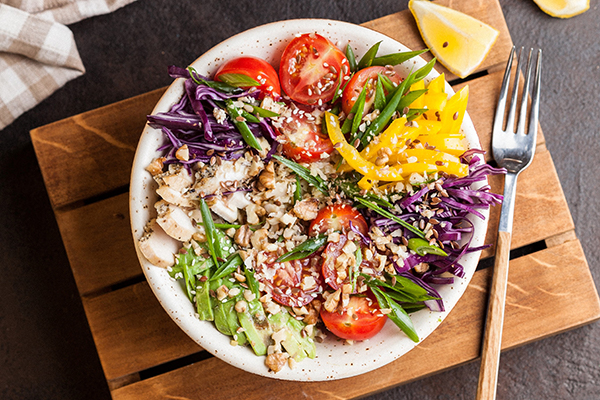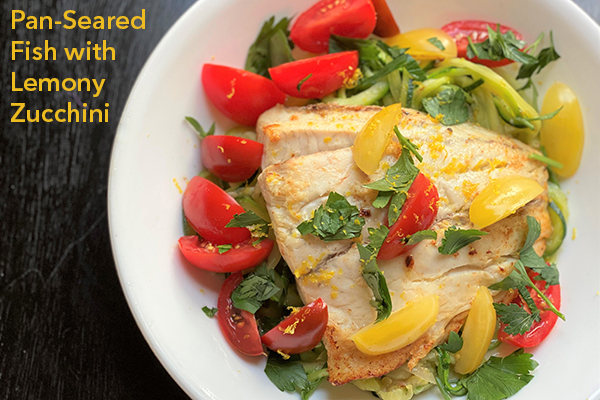Depression and anxiety are the two most common mental health issues in the U.S. Over the past decade or so, more and more research is linking these common issues with lifestyle habits, meaning that what we eat and how much we move, sleep, play and stress out can affect our mental health. This doesn’t mean that medications and talk therapy aren’t helpful, it just means that maybe they shouldn’t be the only focus.
The foods you choose can have a powerful impact on your mood and overall brain health. Poor diet is a major contributing factor to the epidemic of depression and anxiety. There are many studies showing the direct connection between diet and depression. Unfortunately, there are fewer studies that directly link diet and anxiety but there is research that connects inflammation, oxidative stress and alterations to the microbiome with anxiety, all of which are highly influenced by diet.
The foods you choose have a powerful impact on your mood. #saslife Click To TweetFood and Mood
I don’t think it’s any surprise that a diet high in fast food, soda, highly processed foods, etc. (the “Western Diet”) is associated with an increased risk of depression, anxiety and pretty much every chronic disease out there. While a diet rich in real whole foods like vegetables, whole grains and fish (like a Mediterranean diet) is associated with a lower risk of depression and anxiety (as shown by this review and this study).
So, let’s get right to the good stuff. What should we eat, and what should we limit?
Reducing inflammation, correcting nutrient deficiencies and improving the gut microbiome seem to be the top dietary factors that impact mood issues. We want to eat in a way that provides our brain with all the nutrients it needs to function optimally and for neurotransmitter production (adequate protein). We also want to reduce inflammation, maintain balanced blood glucose levels, and support a healthy gut microbiome.
We want to eat:
- Low glycemic real, whole foods-based eating plan
- Protein with each meal
- needs vary, 1g/kg - 1.5g/kg body weight
- 8-10 servings of non-starchy vegetables per day
- a colorful variety (work up to this amount)
- 2 servings of whole fruit per day
- again, a colorful variety
- High quality oils and fats
- avocados, extra virgin olive oil, raw nuts, and seeds
- 2-3 servings of omega-3 rich fish per week
- wild salmon, sardines, mackerel, herring
- 1-3 servings of nutrient dense carbohydrates per day
- whole grains, starchy vegetables, legumes
- Lots of antioxidant rich herbs and spices
- Fermented foods at least 4 times a week
- kefir, sauerkraut, kimchi
We want to limit: *
- Excess calories
- Excess caffeine
- Highly processed foods
- highly processed carbohydrates, processed meats, industrial seed oils
- Excess added sugars
- Alcohol
- Oxidized fats, trans fats
- found in highly processed foods
- Artificial colors, preservatives artificial sweeteners
*These types of foods can basically increase inflammation and oxidative stress and can lead to nutrient deficiencies and an unhealthy microbiome.
Other factors that impact mood
Sleep, stress, and movement can also play a huge role in our mood and brain health. Check out this seminar to learn more about Lifestyle Strategies for Depression and Anxiety and more details about how our food choices impact our mood.
NOTE: It’s important to know that other disease states can lead to depression and anxiety, such as thyroid issues or insulin resistance – check with your health care provider first.
Pan-Seared Fish with Lemony Zucchini
Recipe Adapted from Feasting at Home
Makes 2 servings
PRINT RECIPE
Ingredients
For the fish
8–10 oz baramundi (or sub salmon, tofu, halibut, cod, scallops, shrimp)
1 garlic clove, smashed
1–2 Tbsp olive oil
salt and pepper, to taste
For the zucchini
1 Tbsp olive oil
1 shallot, sliced thin
3 garlic cloves, rough chopped
12–16 oz zucchini noodles (zoodles) or 2-3 zucchini, diced
salt and pepper, to taste
2 tsp lemon zest
½ cup chopped fresh Italian parsley (or sub ¼ cup basil)
1 Tbsp lemon juice (or more to taste)
Garnishes
sweet cherry tomatoes, chili flakes, shaved pecorino cheese (optional)
Directions
- Preheat oven to 375º
- Heat oil in a medium skillet over medium heat. Add smashed garlic and swirl to infuse garlic into the oil.
- Pat fish dry and season with salt and pepper. Sear both sides until golden. (TIP: If you let the fish sear without moving it too much, it will form a crust and release itself naturally from the pan. If it sticks, it is usually that you are moving or lifting it too soon.) Once both sides are golden, place in the warm oven until cooked through to your liking, roughly 3 – 6 minutes; time will depend on thickness of the cut.
- In a large skillet, heat more oil over medium heat and add shallots and garlic, stirring until softened and fragrant, about 3 minutes.
- Add zucchini noodles and season with salt and pepper. Sauté until noodles soften, about 4 minutes. Toss in lemon zest, fresh parsley and a squeeze of lemon. Taste for salt and lemon and adjust if necessary.
- Divide among two bowls and top with cooked fish. Garnish with fresh halved cherry tomatoes, and optional chili flakes and shaved pecorino cheese if you like.
Note: You don’t have to use zucchini noodles, diced zucchini tastes just as good.






